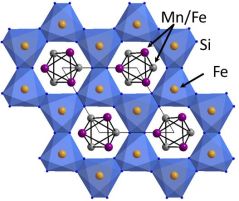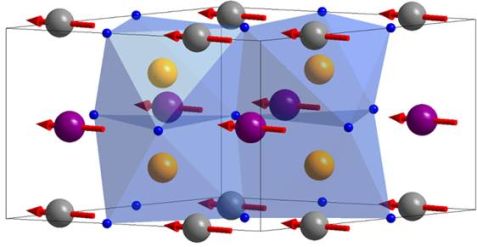MLZ ist eine Kooperation aus:
 > Technische Universität München
> Technische Universität München > Helmholtz-Zentrum Hereon
> Helmholtz-Zentrum Hereon
 > Forschungszentrum Jülich
> Forschungszentrum Jülich
MLZ ist Mitglied in:
 > LENS
> LENS > ERF-AISBL
> ERF-AISBL
MLZ in den sozialen Medien:

MLZ
Lichtenbergstr.1
85748 Garching
Anisotropy in the magnetocaloric effect of MnFe4Si3
P. Hering1, K. Friese1, J. Voigt1, A. Grzechnik2, A. Senyshyn3, M. Meven1,2, T. Brückel1,4
1 Jülich Centre for Neutron Science and Peter Grünberg Institut, Forschungszentrum Jülich GmbH, Jülich, Germany
2 Institute for Crystallography, RWTH Aachen University at MLZ, Aachen, Germany
3 Heinz Maier-Leibnitz Zentrum (MLZ), Technische Universität München, Garching, Germany
4 Jülich Centre for Neutron Science (JCNS) at MLZ, Forschungszentrum Jülich GmbH, Garching, Germany
The magnetocaloric effect describes the change in temperature of a material when exposed to a magnetic field and forms the basis of magnetocaloric refrigeration technologies. We studied the anisotropic lattice expansion of the magnetocaloric compound MnFe4Si3, which exhibits a distinct anomaly at the ferromagnetic ordering temperature as revealed by neutron powder diffraction at SPODI. The close relation between the lattice and spin degrees of freedom might be responsible for the large magnetocaloric effect (MCE) in this compound. In addition, a combined neutron and X-ray single crystal diffraction study revealed new details of the nuclear and magnetic structure. A new structural model in the space group P-6 was introduced and the magnetic structure was determined in the magnetic space group Pm’, with an easy axis of magnetization in the a,b-plane.
MnFe4Si3 and the magnetocaloric effect

Figure 1: Projection of the crystal structure of MnFe[~4~]Si[~3~] along [001]. FeSi[~6~]-Octahedra are indicated.
Magnetic refrigeration technologies hold the potential for 20-30 % lower energy consumption when compared to conventional vapor compression cooling [1]. Within the system Mn5-xFexSi3, the hexagonal compound MnFe4Si3 is a promising candidate for magnetic cooling in ambient temperature devices. Compared to other candidate materials, it has the advantage that it does not contain expensive rare earth elements such as Gd, nor toxic elements such as As. In addition, this compound is a good candidate for developing a better understanding of the underlying mechanism of the MCE in multiple site driven magnetocaloric materials [2].
Magnetic structure

Figure 2: Ferromagnetic structure of MnFe[~4~]Si[~3~]. The spins in the mixed occupancy site are indicated.
Earlier studies based on polycrystalline samples report a crystal structure in the space group P63/mcm with three symmetrically independent atomic positions: the first site has mixed occupancy of manganese and iron, a second site is exclusively occupied by Fe while the third is occupied by silicon (Fig. 1). We were able to synthesize single crystals of the compound using the Czochralski method, which opened up the possibility of studying the anisotropy of the magnetic properties along with single crystal X-ray and neutron diffraction experiments. A refinement of the crystal structure using neutron and X-ray data simultaneously led to a structural model in the space group P-6. The main difference in our new structural model, when compared to the previous model, is a partial ordering of the manganese and iron in the mixed occupied sites, revealed only because of the enhanced contrast between Fe and Mn in neutron scattering.
MnFe4Si3 undergoes a magnetic transition to a ferromagnetic phase around 300 K [3, 4]. A refinement of the magnetic structure with the single crystal neutron data measured on TRICS (PSI) showed that the magnetic moments are coupled ferromagnetically and that the spins in the mixed occupancy sites are aligned in the a,b-plane (Fig. 2). Magnetic susceptibility measurements confirm this easy plane of magnetization [5]. No significant magnetic moment could be refined for the sites which are exclusively occupied by Fe. In addition, the intensities of symmetry equivalent reflections which are dominated by the magnetic scattering contribution were monitored on HEIDI (MLZ) over a broad temperature range and allowed to determine a Tc of 305(2) K (Fig. 3).
![fig3: Anisotropy in the magnetocaloric effect of MnFe[~4~]Si[~3~] fig3: Anisotropy in the magnetocaloric effect of MnFe[~4~]Si[~3~]](/media/index.php?rex_media_type=noresize&rex_media_file=figure3_3.jpg)
Figure 3: Temperature dependence of several reflections dominated by the contribution from magnetic scattering as measured on HEIDI (MLZ).
Anisotropy of thermal expansion
![fig4: Anisotropy in the magnetocaloric effect of MnFe[~4~]Si[~3~] fig4: Anisotropy in the magnetocaloric effect of MnFe[~4~]Si[~3~]](/media/index.php?rex_media_type=content_half&rex_media_file=figure4_1.jpg)
Figure 4: Normalized lattice parameter and unit cell volume of MnFe[~4~]Si[~3~] as a function of temperature using the values at 300 K for normalization.
A large MCE is often related to a pronounced interplay between spin and lattice degrees of freedom [6]. In order to study this interplay and to characterize the effect of the magnetic ordering on the crystal lattice and structure, we also measured powder diffraction diagrams of MnFe4Si3 on the high resolution powder diffractometer SPODI at MLZ in the temperature range from 4 K up to 470 K. SPODI provides the possibility of measuring the whole temperature range without changing the experimental setup and, thus, enables an internally consistent data treatment to be applied for all measurements. Thermal dependence of the refined lattice parameters (Fig. 4) reveals a strong anisotropic thermal expansion of MnFe4Si3. The hexagonal unit cell expands mainly along the c-direction while the a-lattice parameter undergoes changes which are smaller by one order of magnitude. However, the a-lattice parameter exhibits a distinct minimum in the temperature range of the magnetic transition temperature (see arrow in Fig. 4) and nicely reflects a close relation between the lattice and spin degrees of freedom [5].
Conclusion
Neutron scattering experiments reveal two different – probably to a large degree independent – magnetic systems in the compound MnFe4Si3. This observation, together with the strong anisotropy in the thermal expansion of the crystal lattice and the pronounced structural response to the magnetic transition, might be the key to the occurrence of a large magnetocaloric effect in other magnetocaloric materials too.
References:
[1] K. A. Gscheidner Jr. et al., Int. J. Refrig. 31, 945 (2008).
[2] L. Caron et al., Phys. Rev. B 88, 094440 (2013).
[3] H. Binczycka et al., Phys. Status Solidi A-Appl. Mat. 19, K13 (1973).
[4] Songlin et al., J. Alloy. Compd. 334, 249 (2002).
[5] P. Hering et al., Chem. Mat. 27 (20), 7128 (2015).
[6] V. K. Pecharsky et al., Int. J. Refrig. 29, 1239 (2006).
MLZ ist eine Kooperation aus:
 > Technische Universität München
> Technische Universität München > Helmholtz-Zentrum Hereon
> Helmholtz-Zentrum Hereon
 > Forschungszentrum Jülich
> Forschungszentrum Jülich
MLZ ist Mitglied in:
 > LENS
> LENS > ERF-AISBL
> ERF-AISBL
MLZ in den sozialen Medien:


